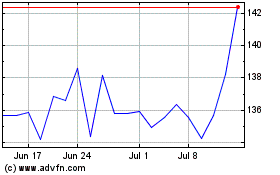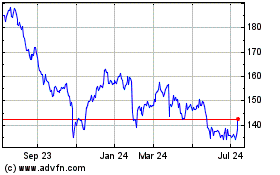UPS Battles Costs From E-Commerce Surge -- WSJ
February 01 2017 - 3:03AM
Dow Jones News
Carrier strains to keep up with e-commerce shift
By Paul Ziobro
United Parcel Service Inc. was stung by the rapid shift to
e-commerce this past holiday season, as higher costs from a glut of
package deliveries hurt its bottom line.
The Atlanta-based carrier posted higher sales in its fourth
quarter, but profit margins fell as its home deliveries outpaced
its more profitable business-to-business segment. UPS pledged to
spend $4 billion this year, a 33% increase from 2016, as it tries
to keep up with consumers' shift to online shopping.
"E-commerce brings challenges, it certainly brings great
opportunities," UPS Chief Executive David Abney said Tuesday on a
call with analysts. "If this quarter taught us anything, we've got
to quicken the pace."
UPS also issued a downbeat profit outlook below analysts'
estimates due to lower profits from residential deliveries and a
stronger U.S. dollar.
UPS shares fell 6.2% in early trading to $109.65. Rival FedEx
Corp. also fell 2.4% to $188.67.
As more people shop online, UPS and FedEx are struggling to keep
up with the extra costs of having its drivers stop at homes and
apartment buildings. UPS said 55% of shipments in the quarter were
to residential addresses, including 63% of all deliveries in
December.
The company is trying to offset the added costs of those
deliveries with new routing systems that optimize routes and
bundling orders to be delivered on certain days.
It is also raising prices so that it can recoup the higher
delivery costs as well as the additional investments it is making
to handle the increased volume. Last year, UPS spent nearly $3
billion on capital expenditures, including adding 7 million square
feet of new capacity.
"We have to put more emphasis on making sure that we pass on to
our customers the increase in costs that e-commerce deliveries can
bring," Mr. Abney said in an interview.
He added that in the company's negotiations with larger
customers about rate increases, UPS hasn't gotten "any more
pushback than we'd get any year."
In all for the quarter, UPS reported a loss $239 million, or 27
cents a share, compared with a profit of $1.33 billion, or $1.48 a
share, a year earlier.
Excluding items such as a mark-to-market pension charge,
earnings rose to $1.63 a share from $1.57. The most-recent quarter
included mark-to-market expenses of $1.67 billion, while the
charges for the year-earlier quarter totaled $79 million.
Revenue grew 5.5% to $16.93 billion. On an adjusted basis, the
company said revenue was $16.99 billion.
For the year, UPS is forecasting earnings of $5.80 to $6.10 per
share, below the $6.17 expected by analysts polled by Thomson
Reuters.
The weaker forecast comes even as the carrier anticipates
stronger economic conditions in the U.S., with the White House
expected to push for lower tax rates and infrastructure
investments.
"There's a big focus on the economy," Mr. Abney said. "That
excites us because economic growth is the wood that starts our
fire."
Imani Moise contributed to this article.
Write to Paul Ziobro at Paul.Ziobro@wsj.com
(END) Dow Jones Newswires
February 01, 2017 02:48 ET (07:48 GMT)
Copyright (c) 2017 Dow Jones & Company, Inc.
United Parcel Service (NYSE:UPS)
Historical Stock Chart
From Aug 2024 to Sep 2024

United Parcel Service (NYSE:UPS)
Historical Stock Chart
From Sep 2023 to Sep 2024
